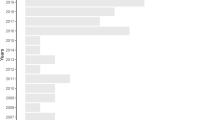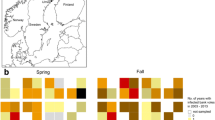Abstract
Mycobacterium ulcerans infection (Buruli ulcer [BU] disease) is an emerging tropical disease that causes severe morbidity in many communities, especially those in close proximity to aquatic environments. Research and control efforts are severely hampered by the paucity of data regarding the ecology of this disease; for example, the vectors and modes of transmission remain unknown. It is hypothesized that BU presence is associated with altered landscapes that perturb aquatic ecosystems; however, this has yet to be quantified over large spatial scales. We quantified relationships between land use/land cover (LULC) characteristics surrounding individual villages and BU presence in Benin, West Africa. We also examined the effects of other village-level characteristics which we hypothesized to affect BU presence, such as village distance to the nearest river. We found that as the percent urban land use in a 50-km buffer surrounding a village increased, the probability of BU presence decreased. Conversely, as the percent agricultural land use in a 20-km buffer surrounding a village increased, the probability of BU presence increased. Landscape-based models had predictive ability when predicting BU presence using validation data sets from Benin and Ghana, West Africa. Our analyses suggest that relatively small amounts of urbanization are associated with a decrease in the probability of BU presence, and we hypothesize that this is due to the increased availability of pumped water in urban environments. Our models provide an initial approach to predicting the probability of BU presence over large spatial scales in Benin and Ghana, using readily available land use data.


Similar content being viewed by others
References
Aiga H, Amano T, Cairncross S, Domako JA, Nanas O-K, Coleman S (2004) Assessing water-related risk factors for Buruli ulcer: a case-control study in Ghana. The American Journal of Tropical Medicine and Hygiene 71:387–392
Asiedu K, Etuaful S (1998) Socioeconomic implications of Buruli ulcer in Ghana: a three-year study. The American Journal of Tropical Medicine and Hygiene 59:1015–1022
Barker DJP (1973) Epidemiology of Mycobacterium ulcerans infection. Transactions of the Royal Society of Tropical Medicine and Hygiene 67:43–47
Barker DJP, Carswell JW (1973) Mycobacterium ulcerans infection among tsetse control workers in Uganda. International Journal of Epidemiology 2:161–165
Boyd H A, Waller LA, Flanders WD, Beach MJ, Sivilus JS, Lovince R, et al. (2004) Community, and individual-level determinants of Wuchereria bancrofti infection in Leogane Commune, Haiti. American Journal of Tropical Medicine and Hygiene 70:266–272
Ceballos G, Ehrlich PR (2002) Mammal population losses and the extinction crisis. Science 296:904–907
Cunningham MA (2006) Accuracy assessment of digitized and classified land cover data for wildlife habitat. Landscape and Urban Planning 78:217–228
Debacker M, Portaels F, Aguiar J, Steunou C, Zinsou C, Meyers W, et al. (2006) Risk factors for Buruli ulcer, Benin. Emerging Infectious Diseases 12:1325–1331
Duker AA, Carranza EJM, Hale M (2004) Spatial dependency of Buruli ulcer prevalence on arsenic-enriched domains in Amansie West District, Ghana: implications for arsenic mediation in Mycobacterium ulcerans infection. International Journal of Health Geographics 3:19
Ellison AM (2004) Bayesian inference in ecology. Ecology Letters 7:509–520
Farnsworth ML, Wolfe LL, Hobbs T, Burnham KP, Williams ES, Theobald DM, et al. (2005) Human land use influences chronic wasting disease prevalence in mule deer. Ecological Applications 15:119–126
Forman RTT (1995) Land Mosaics: The Ecology of Landscapes and Regions. Cambridge, UK: Cambridge University Press
Gelman A, Carlin JB, Stern HS, Rubin DB (2004) Bayesian Data Analysis, 2nd ed. New York: Chapman and Hall, CRC
ESRI (2005) ArcMap 9.1 software. Available: http://www.esri.com
Hakre S, Masuoka P, Vanzie E, Roberts DR (2004) Spatial correlations of mapped malaria rates with environmental factors in Belize, Central America. International Journal of Health Geographics 3:6
Hayman J (1991) Postulated epidemiology of Mycobacterium ulcerans infection. International Journal of Epidemiology 20:1093–1098
Hayman J, Asiedu K (2000) Epidemiology. In: Mycobacterium ulcerans Infection, Asiedu K, Scherpbier R, Raviglione M (editors), Geneva: World Health Organization, pp 9–14
Horsburgh CR Jr, Meyers WM (1997) Buruli ulcer. In: Pathology of Emerging Infections, Horsburgh CR Jr, Nelson AM (editors), Washington, DC: American Society for Microbiology, pp 119–126
Jackson LE, Hilborn ED, Thomas JC (2006) Towards landscape design guidelines for reducing Lyme disease risk. International Journal of Epidemiology 35:315–322
Johnson PDR, Stinear TP, Hayman JA (1999) Mycobacterium ulcerans—a mini-review. Journal of Medical Microbiology 48:511–513
Johnson PDR, Stinear TP, Small PLC, Pluschke G, Merritt RW, Portaels F, et al. (2005a) Buruli ulcer—new insights, new hope for disease control. PLoS Medicine 2:e108
Johnson RC, Makoutodé M, Sopoh GE, Elsen P, Gbovi J, Pouteau LH, et al. (2005b) Buruli ulcer distribution in Benin. Emerging Infectious Diseases 11:500–501
King RS, Baker ME, Whigham DF, Weller DE, Jordan TE, Kazyak PF, et al. (2005) Spatial considerations for linking watershed land cover to ecological indicators in streams. Ecological Applications 15:137–153
Klinkenberg E, McCall PJ, Hastings IM, Wilson MD, Amerasinghe FP, Donnelly MJ (2005) Malaria and irrigated crops, Accra, Ghana. Emerging Infectious Diseases 11:1290–1293
Lillesand TM, Kiefer RW (2000) Remote Sensing and Image Interpretation, 4th ed. New York: John Wiley & Sons
Linderman MA, An L, Bearer S, He G, Ouyang Z, Liu J (2006) Interactive effects of natural and human disturbances on vegetation dynamics across landscapes. Ecological Applications 16:452–463
Marsollier L, Aubry J, Saint-Andre J-P, Robert R, Legras P, Manceau A-L, et al. (2003) Ecology and transmission of Mycobacterium ulcerans. Pathologie Biologie 51:490–495
Marston BJ, Diallo MO, Horsburgh CR, Diomande I, Saki MZ, Kanga J, et al. (1995) Emergence of Buruli ulcer disease in the Daloa region of Côte d’Ivoire. American Journal of Tropical Medicine and Hygiene 52:219–224
Merritt R, Benbow M, Small P (2005) Unraveling an emerging disease associated with disturbed aquatic environments: the case of Buruli ulcer. Frontiers in Ecology and the Environment 3:323–331
Moloney KA, Levin SA (1996) The effects of disturbance architecture on landscape-level population dynamics. Ecology 77:375–394
Portaels F (1989) Epidémiologie des ulcères à Mycobacterium ulcerans. Annales de la Societe Belge de Medecine Tropicale 69:91–103
Portaels F, Elsen P, Guimaraes-Peres A, Fonteyne P, Meyers WM (1999) Insects in the transmission of Mycobacterium ulcerans infection. The Lancet 353:986
Radford AJ (1975) Mycobacterium ulcerans in Australia. Australian & New Zealand Journal of Medicine 5:162–169
Raghunathan PL, Whitney EAS, Asamoa K, Stienstra Y, Taylor TH Jr, Amofah GK, et al. (2005) Risk factors for Buruli ulcer disease (Mycobacterium ulcerans infection): results from a case-control study in Ghana. Clinical Infectious Diseases 40:1445–1453
Rapport de l’Enquête (2003) Statistique Agricole 1992–93 (ESA-92), Vols 1, 2, June 2003
SAS Institute (2000) SAS/STAT User’s Guide. Cary, NC: SAS Institute
Smith KF, Dobson AP, McKenzie FE, Real LA, Smith DL, Wilson ML (2005) Ecological theory to enhance infectious disease control and public health policy. Frontiers in Ecology and the Environment 3:29–37
Sopoh GE, Johnson RC, Chauty A, Dossou AD, Aguiar J, Salmon O, et al. (2007) Buruli ulcer surveillance, Benin, 2003–2005. Emerging Infectious Diseases 13:1374–1376
Spiegelhalter DJ, Best NG, Carlin BP, Linde AVD (2002) Bayesian measures of model complexity and fit. Journal of the Royal Statistical Society: Series B (Statistical Methodology) 64:583–639
Spiegelhalter DJ, Thomas A, Best N, Lunn D (2004) WinBUGS User Manual. Version 1.4
Stienstra Y, Van der Graaf WTA, Asamoa K, Van der Werf TS (2002) Beliefs and attitudes toward Buruli ulcer in Ghana. American Journal of Tropical Medicine and Hygiene 67:207–213
Thangaraj HS, Evans MRW, Wansbrough-Jones MH (1999) Mycobacterium ulcerans; Buruli ulcer. Transactions of the Royal Society of Tropical Medicine and Hygiene 93:337–340
van der Werf TS, Stienstra Y, Johnson C, Phillips R, Adjei O, Fleischer B, et al. (2005) Mycobacterium ulcerans disease. Bulletin of the World Health Organization 83:785–791
Wagner T, Hayes DB, Bremigan MT (2006a) Accounting for multilevel data structures in fisheries data using mixed models. Fisheries 31:180–187
Wagner T, Jubar AK, Bremigan MT (2006b) Can habitat alteration and spring angling explain black bass nest distribution and success? Transactions of the American Fisheries Society 135:843–852
WHO (2000a) Buruli ulcer. Mycobacterium ulcerans infection. Geneva: WHO
WHO (2000b) Buruli ulcer. Mycobacterium ulcerans infection. In: WHOICDS/CPE/GBUIM, WHO, Asiedu K, Scherpbier R, Raviglione M (editors), Geneva: WHO, p 118
Acknowledgments
The authors acknowledge and thank K. Asiedu of the World Health Organization and E. Ampadu of the Ghana Ministry of Health for providing Buruli ulcer case data and R. Kolar for managing the Buruli ulcer case data. We also thank Dr. L. Waller for helpful comments on an earlier draft of this manuscript. This work was funded by NIH grants 1R01 TW007550-01 and 1R03 AI062719-01A1, the former an award through Fogarty International Center and the NIH/NSF Ecology of Infectious Diseases Program. This is publication 2007-08 of the Quantitative Fisheries Center.
Author information
Authors and Affiliations
Corresponding author
Rights and permissions
About this article
Cite this article
Wagner, T., Benbow, M.E., Burns, M. et al. A Landscape-based Model for Predicting Mycobacterium ulcerans Infection (Buruli Ulcer Disease) Presence in Benin, West Africa. EcoHealth 5, 69–79 (2008). https://doi.org/10.1007/s10393-007-0148-7
Received:
Revised:
Accepted:
Published:
Issue Date:
DOI: https://doi.org/10.1007/s10393-007-0148-7




